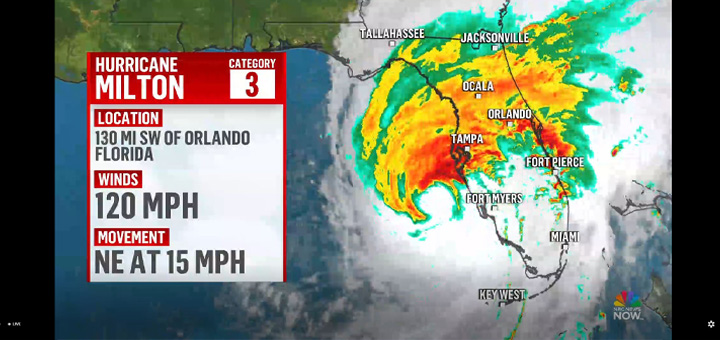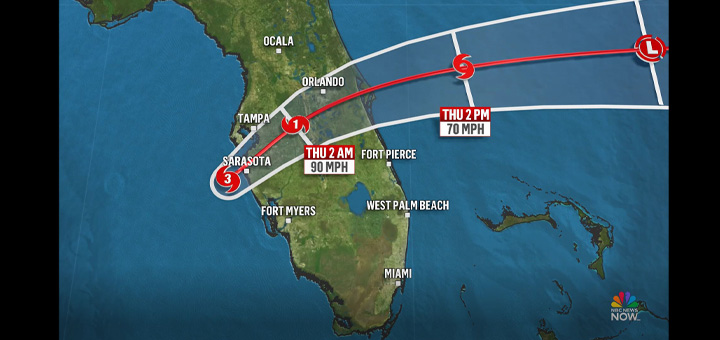
Hurricane Milton dips to Category 3 as it heads for Florida landfall
Hurricane Milton weakened slightly to a still-powerful Category 3 storm Wednesday on a path toward Florida’s central west coast, the National Hurricane Center said.
The northern eyewall of Hurricane Milton began moving ashore around 7 p.m. ET, the National Hurricane Center reported. CBS News meteorologist Nikki Nolan said landfall is likely between 9 p.m. and 10 p.m. ET, if the storm’s directional speed remains the same.
The hurricane center warned those in the Tampa and St. Petersburg areas to shelter in place as “extremely dangerous hurricane-force winds” were spreading through the area.
Earlier in the day, the National Weather Service in Miami observed at least four twisters, including a “multi-vortex tornado,” as meteorologists reported storm surge starting to arrive along the southwestern Florida coast. Tornado warnings were issued for multiple cities, adding to hurricane and storm surge warnings already in place for many of those same places.
After unfurling into an explosive, massive Category 5 storm with formidable winds topping 180 mph on Monday, Milton’s sustained wind speeds began to decline as the storm approached landfall. Earlier, forecasters described it as a “catastrophic” hurricane.
As of 5 p.m. ET Wednesday, maximum sustained winds were at 120 mph.
“Fluctuations in intensity are likely while Milton moves across the eastern Gulf of Mexico, but Milton is expected to be a dangerous major hurricane when it reaches the west-central coast of Florida,” the Miami-based hurricane center said.
What time will Hurricane Milton make landfall?
Milton’s landfall is expected to come between 9 p.m. and 10 p.m. ET Wednesday night as it barrels towards the Sarasota area at a speed of about 15 mph. That is sooner than had previously been forecast.
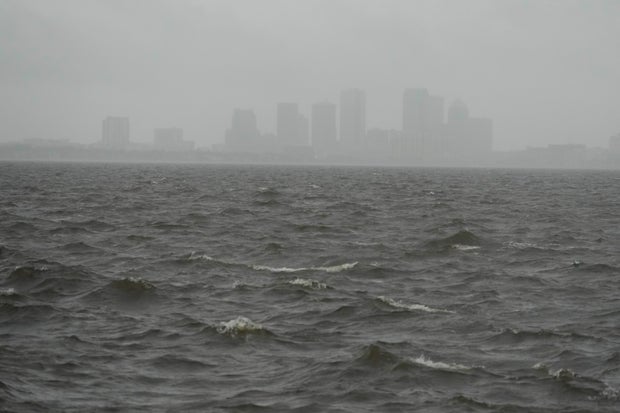
Rain begins to fall ahead of the arrival of Hurricane Milton, Wednesday, Oct. 9, 2024, in Tampa, Fla.
Julio Cortez / AP
After landfall, Milton will continue across Florida while rapidly weakening after losing the fuel of the warm Gulf waters, but still maintaining its hurricane status as it exits into the Atlantic Ocean before quickly transitioning into a tropical storm Thursday afternoon.
Hurricane Milton live radar map
This radar loop from CBS Miami shows weather conditions from Hurricane Milton over Florida and the Gulf of Mexico.

CBS Miami
Hurricane and storm surge warnings
A hurricane warning was in effect for the Florida west coast from Bonita Beach north to Suwannee River, including Tampa Bay, and the state’s east coast from the St. Lucie-Martin County line north to Ponte Vedra Beach.
Storm surge threats are a major concern for the west coast of Florida. In addition to hurricane warnings, storm surge warnings were in effect from Flamingo northward to Yankeetown, including Charlotte Harbor and Tampa Bay.
A storm surge warning was also in effect for Florida’s east coast, from the Sebastian Inlet in Florida, to Georgia’s Altamaha Sound, including the St. Johns River.
Multiple areas were also under tropical storm watches and warnings, including portions of Georgia and the Bahamas.
The National Weather Service said, “If you are in the Storm Surge Warning area, this is an extremely life-threatening situation and you should evacuate if ordered to do so by local officials.”

Peak surge forecasts ahead of Hurricane Milton’s expected arrival.
NOAA/National Hurricane Center
The hurricane center warned that storm surge in the Tampa Bay area could reach 8 to 12 feet above ground level. That prediction was a few feet lower than it had been in earlier forecasts, which initially suggested Tampa could see surges up to 15 feet.
As forecasters’ landfall predictions shifted southward, so did their storm surge estimates. As of Wednesday afternoon, a stretch of Florida’s west coast from Anna Maria Island down to Boca Grande, including Sarasota, was forecast to see peak surges between 9 and 13 feet — about as high or slightly higher than a single story building.
Those afternoon numbers were revised down a touch from earlier ones, but Florida officials and forecasters emphasized that even the lower estimates were extreme.
“The deepest water will occur along the immediate coast near and to the south of the landfall location, where the surge will be accompanied by large and dangerous waves,” the hurricane center said in a Monday afternoon advisory. “Surge-related flooding depends on the relative timing of the surge and the tidal cycle, and can vary greatly over short distances.”
Forecasts show heavy rainfall, up to 18 inches in certain areas, could cause “catastrophic and life-threatening flash and urban flooding, along with moderate to major river flooding” in parts of the Florida peninsula through Thursday.
Mass evacuations ahead of the storm
Mass evacuations clogged highways as people prepared for Milton’s potentially historic impact. Some communities, like those in and around the Tampa Bay area, were still reeling from Hurricane Helene less than two weeks ago.
In a briefing Tuesday, Florida Gov. Ron DeSantis said warned people that “we’re going to have impacts far beyond wherever the eye of the storm is.”
He added, “The impacts will be broader … specifically with respect to storm surge.”
On Wednesday he was even more blunt: “There will be fatalities,” DeSantis said. “I don’t think there’s any way around that when you have 10 feet of storm surge. There are going to be people who stay behind, and they’re going to be in distress.”
Officials have set up 149 shelters across Florida that are open to the general population, with enough capacity to hold around 200,000, the governor said.
Floridians in the potential path of the hurricane lined properties with sandbags, boarded up doors and windows, and moved their boats ahead of the storm’s arrival. DeSantis issued emergency orders over the weekend that now include 51 counties, whose residents, he said, should prepare for power outages, stock up on enough food and water to last a week and be ready to leave their homes if necessary.
Urging people in or around evacuation zones who hadn’t left yet to seek shelter at local or state-run centers established as a response to Milton, DeSantis said Wednesday that time was running out. Key infrastructure like main roads and bridges will likely shut down in some areas as the storm gets closer in the afternoon, and driving has already been challenging since evacuations put jammed highways at 150 to 175% of their capacities.

“Pray for Orlando” reads on wood that was placed at a Home Depot before the arrival of Hurricane Milton, in Orlando, on Oct. 8, 2024.
Jose Luis Gonzalez / REUTERS
According to GasBuddy, as of Wednesday morning, a little more than 23% of Florida gas stations were without fuel, including more than 59% in the area around Tampa Bay and St. Petersburg. Those numbers had climbed since Tuesday night.
Milton has undergone fast-moving and at times dramatic changes over the last few days. In an interview on “CBS Mornings” Wednesday, FEMA administrator Deanne Criswell asked Floridians to listen to local officials as the storm continued to oscillate in terms of strength while approaching landfall and explained some people may not need to travel far when evacuating.
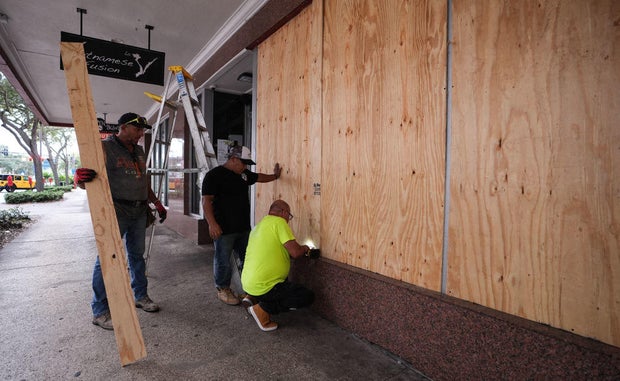
Workers board up a business ahead of Hurricane Milton’s expected landfall in St. Petersburg, Florida, on Oct. 8, 2024.
Lokman Vural Elibol/Anadolu via Getty Images
“The message that I try to get across is when we think about evacuation we often think about these long lines of traffic going out of state when in reality you may only need to go a few miles,” Criswell said. “This is a massive storm that is going to bring catastrophic wind, but also flooding and storm surge, so listen to your local officials. Nobody needs to die from this storm. I want people to get out of harm’s way.”

Duke Energy project manager Tiger Yates, bottom center, walks among hundreds of trucks ready to restore power once Hurricane Milton passes, on Oct. 8, 2024, in The Villages, Fla.
Stephen M. Dowell / Orlando Sentinel via AP
Milton’s peak strength rivaled the most disastrous Atlantic hurricanes in recorded history and happened at breakneck speed. Milton was a tropical storm only 24 hours before it snowballed into a Category 5 hurricane, the highest ranking on the Saffir-Simpson Hurricane Wind Scale, which rates storms based on their sustained wind speeds.
“It is worth emphasizing that this is a very serious situation,” the hurricane center said Tuesday morning. “Milton has the potential to be one of the most destructive hurricanes on record for west-central Florida.”
Tampa-area streets are still lined with miles of debris from Hurricane Helene. The goal, according to Tampa Mayor Jane Castor, was to have most of it cleared by Tuesday, but the city fell short on that.
“Rumors that we don’t have enough resources, that could not be further from the truth,” Castor said in a news briefing Tuesday. “The federal government, the state government, the county, the city, private entities, are working hand-in-hand, first and foremost, to get that household debris up and out of the way, and secondly to make sure everyone is safe as we endure whatever Milton brings our way.”
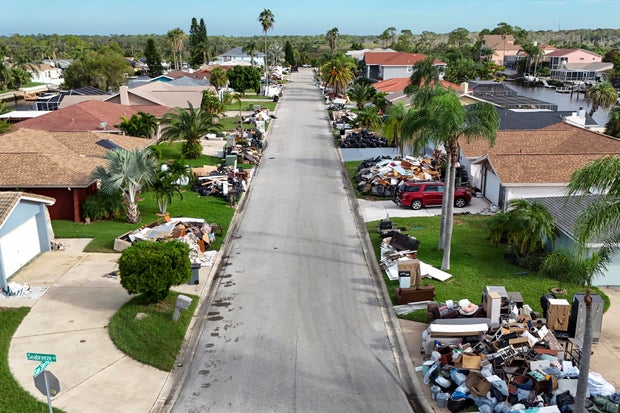
Debris from homes flooded by Hurricane Helene sits curbside as Hurricane Milton approaches on Oct. 8, 2024, in Port Richey, Florida.
AP Photo/Mike Carlson
John Antapasis, emergency management director for the city of Tampa, knows just how vulnerable his city is to hurricanes.
“There’s a lot of vulnerable infrastructure here, and the geography itself that potentially, you know, puts us just much at more risk,” Antapasis said.
Antapasis said the storm surge is the one thing that makes him worry at night when he goes to sleep.
“It’s the storm surge on this one,” Antapasis said. “Ultimately our first responders, we’re going to be here, we’re going to try to save lives, protect property first. And then we will go through that recovery process if that does happen to us.”
Eurydice Stanley rode out Helene in her Tampa-area home, but evacuated to Tallahassee on Monday.
“People are staying at home, but these storms are different, ask the citizens of of Asheville, North Carolina,” Stanley told CBS News.
And while millions of people in the Tampa area are under a mandatory evacuation, and many have left, some aren’t going anywhere. Bridgit Budd, who resides on Sanibel Island, is among those who says she is staying. Budd and her husband have ridden out for major hurricanes before, including Helene.
“There’s just no place I would rather be,” Budd told CBS News. “You know, I don’t suggest it for anybody. I’m not promoting it.”
Travel disrupted
Florida airports canceled flights and some closed ahead of the storm. United said Tuesday night that it had added 18 extra flights out of Florida, as well larger aircraft on four of those flights in an effort to serve as many customers as possible. It said all flights out of Tampa, Fort Myers and Sarasota were full through Thursday.
The Port of Key West has closed ahead of Milton’s arrival, CBS Miami reports, with cruise ships bypassing the port. Several Orlando area theme parks were also shuttering, including Walt Disney World, SeaWorld Orlando and Universal Studios Florida.
Aviation analytics company Circium reported that 80% of flights from Tampa were canceled Tuesday.
“We are talking about the possibility now of a direct hit,” said Tampa Mayor Jane Castor in a CNN interview Monday, where she urged people to heed storm warnings and follow evacuation protocols. Castor noted that storm surge caused by Helene, while destructive, was significantly lower than the surge forecast for a vast stretch of Florida’s western coast, including Tampa, with Milton.
“Helene was a wake-up call. This is literally catastrophic. And I can say, without any dramatization whatsoever, if you choose to stay in one of those evacuation areas, you’re going to die,” Castor said.
President Biden echoed the mayor Tuesday morning as the White House announced he would postpone a trip to Germany and Angola to monitor the response to Hurricane Milton.
“I’ve urged everyone, everyone currently located in Hurricane Milton’s path to listen to local officials and follow safety instructions,” Mr. Biden said. “… If you’re under evacuation orders, you should evacuate now, now, now — you should have already evacuated. It’s a matter of life and death.”
Mr. Biden said he preapproved emergency declarations in Florida and sent Criswell to the state Monday. The president also said he has spoken to all political leaders in the region expected to feel Milton’s impacts and told them, “Anything they ask for, they can get.”
